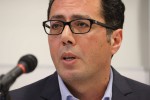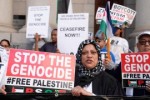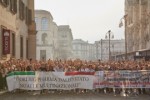My Mum’s Disappearance Was A Mystery. Then I Saw An Old Photo — And What I Discovered Next Left Me Shaken.
I tried not to stare when I first saw her. Her gaunt, heavily lined face made her look older than I expected. She wore a dingy pumpkin-orange thrift-store turtleneck that swallowed her 5-foot-7, 98-pound frame. But her ice-blue eyes sparkled like a kid’s on Christmas morning.
“Oh boy! Oh boy,” she said, walking toward me with outstretched arms. “It’s so good to see you!”
That was the first of many visits. Most followed the same script: her astonished joy upon my arrival, my mechanical hug, and then sitting on her couch to talk about her favourite topic, classic torch love songs from the 1950s and early ’60s.
“Who’s the better singer?” I’d ask. “Frank Sinatra or Nat King Cole?”
She’d close her eyes to ponder. “Nat King Cole,” she’d announce, nodding in reverence.
After about an hour, I’d stand to leave. Her smile would evaporate. Another awkward hug. As I left, she’d call out, “Don’t take any wooden nickels.”
On the surface, we had nothing in common. She was a white Irish Catholic woman who grew up in a family that freely used the N-word, thought that Black people were lazy, and believed that Black and white people should live apart. I was a young Black man who grew up primarily in foster homes in a Black inner-city neighbourhood where just about everyone — including me — regarded white people with distrust or contempt.
Yet she was my mother. And, as the years have passed, she’s become something else. She’s the person I find myself turning to when I struggle with the mixture of emotions that so many Americans are experiencing right now. Many of us are exhausted, demoralised, and drained by constant political and racial divisions. Countless Americans have become, as author David Brooks put it in a recent essay, “passive, discouraged. … They’ve lost the confidence to wish for more.”
I’ve been swimming in this grim national mood for years. As a journalist at CNN and elsewhere, I’ve covered virtually every so-called racially transformative event in America during the past 32 years, from the Rodney King riots in 1992 to the George Floyd “racial reckoning.” All of them generated massive hope for transformational change; all were followed by a massive letdown. At my lowest moments, I’ve wondered whether human beings are too susceptible to racism and tribalism to make democracy work.
But my mother offered another way to look at the future, without ever intending to do so. She was a person who seemed to have no power or reason to hope. Still she, and others like her, gave me the confidence to wish for more.
The author, around age 27, with his mother, Shirley, and his father, Clifton “Tony” Blake Sr. "We are sitting in my father’s house in West Baltimore," the author writes.
***
In the beginning, I thought I’d never know her. When I was born in the mid-1960s, interracial marriage and intimate interracial relationships were illegal in Maryland, as in much of the country. My mother vanished from my life not long after I was born, and so did her family. No one told me why. I didn’t know what she looked like. My father’s name was on my birth certificate, but hers was not. All he told me and my younger brother, Patrick, was this: ”Your mother’s name is Shirley, she’s white, and her family hates Black people.”
Their hatred did not surprise me. I grew up in a West Baltimore neighbourhood that served as the setting for the HBO series “The Wire,” a crime drama that depicted a Black inner-city community ravaged by racism and drug violence. I routinely heard my friends and neighbours refer to white people as “honkies” and “crackers.” I heard white people yell “Nigger!” when I strayed into their neighbourhoods. During my entire time in Baltimore’s public schools — from Head Start to high school graduation — I saw only one white student.
It wasn’t the time or place to be biracial. There were no biracial public figures like former President Barack Obama or former Vice President Kamala Harris when I grew up in the 1970s and early ’80s. I was too ashamed to tell anyone my mother was white. I marked her race as “Black” on school forms. I became a closeted biracial person.
At 17, though, I discovered that there was one place worse than my neighbourhood: where I first met my mom. There was another reason why I tried not to stare when I first saw her. I was trying to hide my emotions because I was in shock. I was standing in the waiting room of a psychiatric facility called Crownsville Hospital Center in rural Maryland.
My mother had been diagnosed with schizophrenia, a severe mental illness. I didn’t make that discovery until I met her in Crownsville. No one in my family, including my father, had told me — not even on the car ride to the hospital. They didn’t know how. My father had waited until I had graduated from high school to suddenly ask me one day if I wanted to meet my mom. He didn’t think I could handle knowing about her illness until I became a young man. Many people didn’t talk openly about mental illness in their families when I met my mother in the early 1980s.
For over 30 years, I blocked out most of the memories from that first meeting, but one detail lingered. Before I left, my mother looked at me and made a request.
“Will you send me a St. Jude prayer book?” she asked.
“Ah, yeah, I will,” I said, not knowing at the time that St. Jude is the patron saint of hopeless causes.
Outwardly, I didn’t skip a beat after that meeting. I attended and graduated from Howard University, a historically Black college in Washington, D.C., where Kamala Harris was a classmate. I became a journalist at several newspapers before joining CNN. But I had stepped out of one closet into another. Now, I was ashamed that my mother had a mental illness. I didn’t even tell my closest friends. It took two years to tell the woman I would date and marry about my mom’s illness — and another two into our marriage before allowing them to meet.
In the life I hid from others, I tried to build a relationship with my mom. I wrote her a flood of letters, telling her about myself, my dreams and my hope that we could get to know each other. There would be no reply for months, and then a letter would finally arrive. I’d tear it open to find a single sheet from a yellow legal pad, with large cursive letters spilling over the margins: “Dear John! I could use some money and to see you in person. Could you send a picture of yourself and Pat for Mother’s Day? I need another St. Jude prayer book. Love, Shirley.”
Personal visits were no better. She would drift away in the middle of conversations. She’d forget what we talked about two minutes earlier. Her lips would tremble, and she’d lapse into silence if I asked too many questions about her past. At times, she’d sense my frustration, turn to me and say with a rueful smile, “Don’t mind me. I’m crazy.”
Each visit left me more depressed. My mother had been a........






















 Toi Staff
Toi Staff Gideon Levy
Gideon Levy Tarik Cyril Amar
Tarik Cyril Amar Dr Ramzy Baroud
Dr Ramzy Baroud Rachel Marsden
Rachel Marsden Belen Fernandez
Belen Fernandez Muhannad Ayyash
Muhannad Ayyash Somdeep Sen
Somdeep Sen Yara Hawari
Yara Hawari Stephanie A. Sarkis Ph.d
Stephanie A. Sarkis Ph.d Maximilian Hess
Maximilian Hess Santiago Zabala
Santiago Zabala
